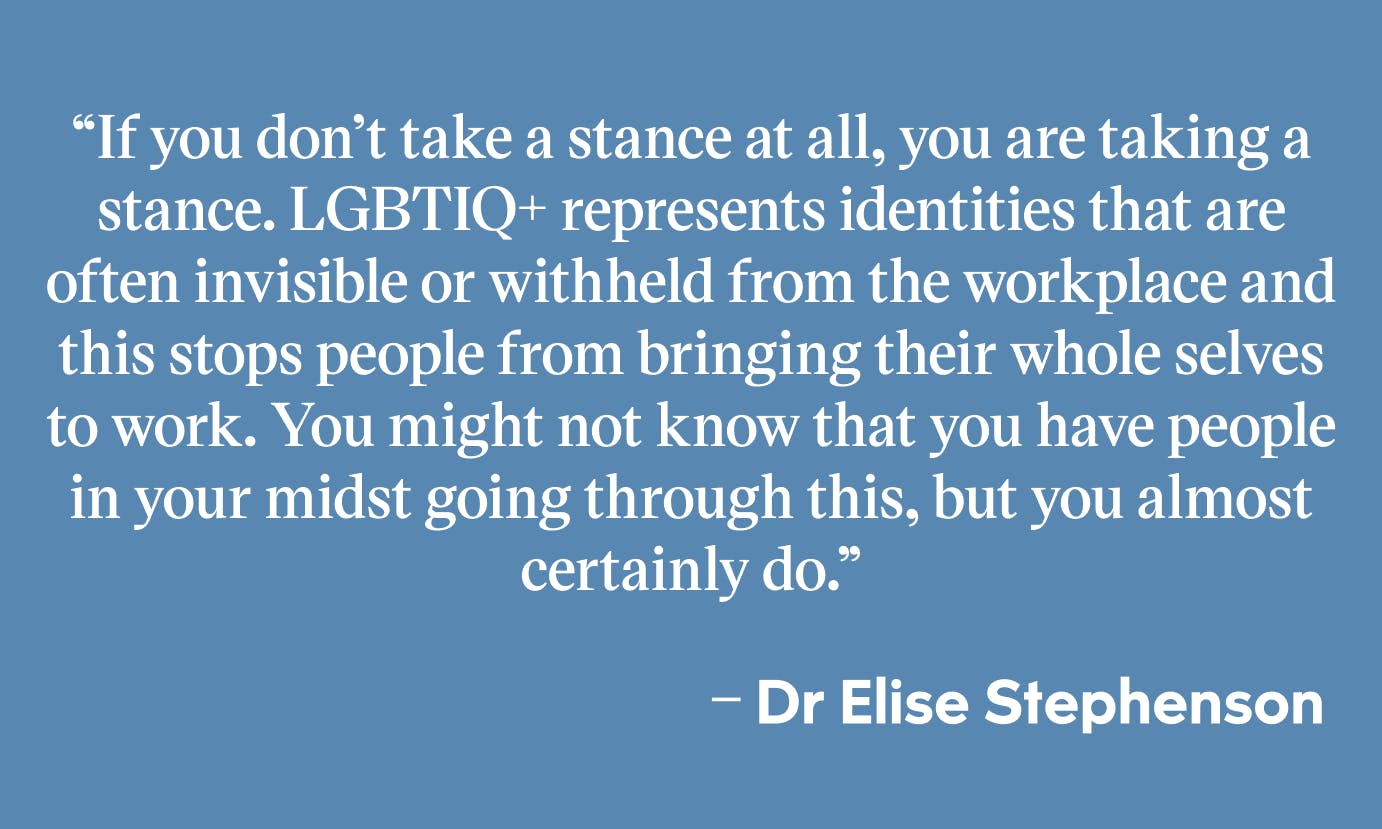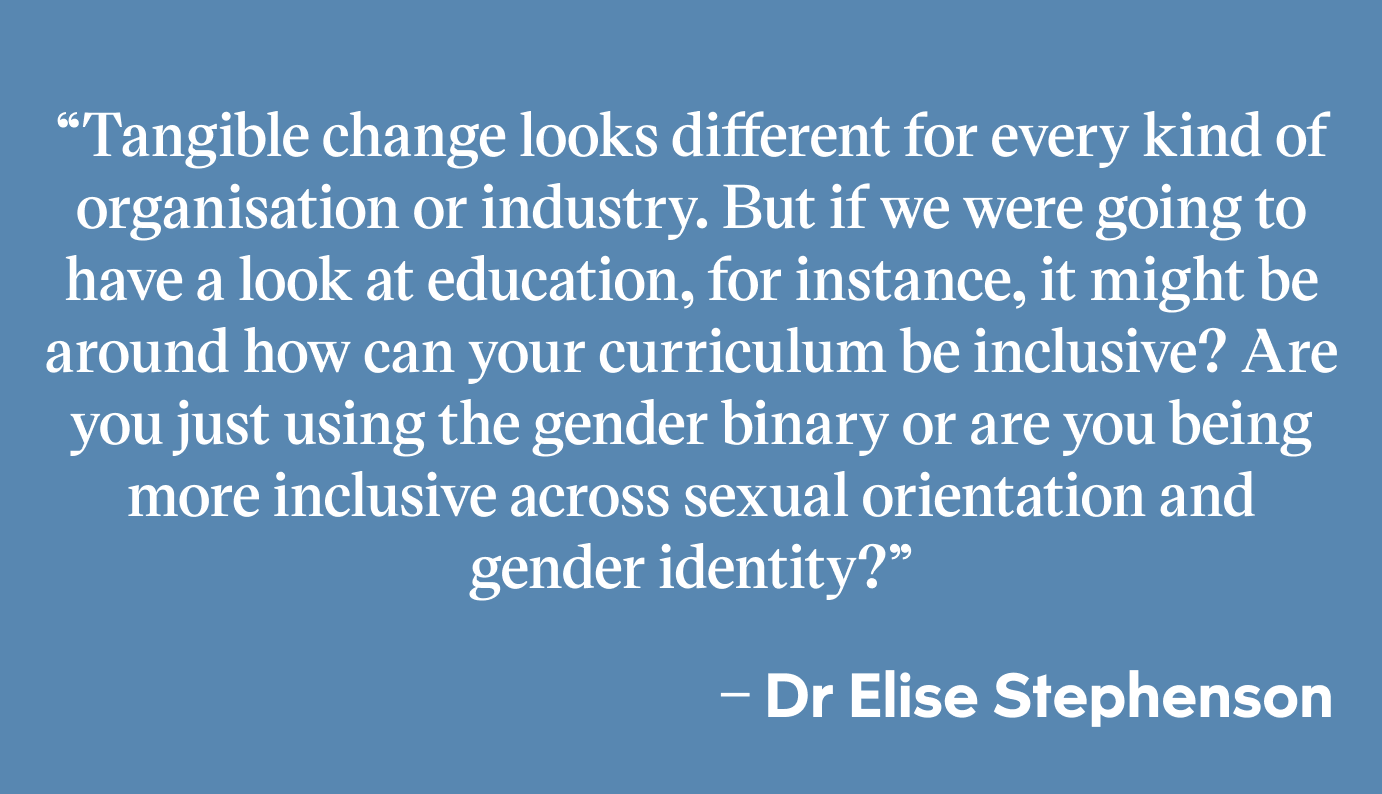
Can L&D best practice improve LGBTIQ+ inclusion at work?

Effective LGBTIQ+ inclusion is fundamental to every workplace. It affects our ability to attract and retain great employees and design market-leading products, as well as our branding and reputation. Most importantly, it allows our employees to bring their full selves to work.
As such, it’s worth asking, how can inclusive workplace learning be more effective? And how can workplaces make sure they’re doing something beyond tokenism when training their employees?
We asked Dr Elise Stephenson, entrepreneur and multi-award winning researcher on gender equality and sexuality from Griffith University, to share her insights on best practice for learning and development at work to help LGBTIQ+ employees thrive.
Why does LGBTIQ+ inclusion at work matter (and how can we get buy-in for the programs we need to roll out)?
Sometimes it can be difficult for us to separate our personal feelings about social issues from their impact on the workplace. It is only recently that we’ve seen marriage equality legislated in many countries, while homosexuality is still illegal in some places. However, when we focus on the workplace, there is a clear case for meaningful and lasting action.
If we make the workplace a safe space for people to share their true selves, employees tend to work harder and treat each other better. As a result, output improves. If we don’t, then not only are we unable to properly care for our employees, but we risk damage to our brand and our product, as well as significant impacts to our bottom line from absenteeism, discrimination, bullying, and harassment.
In this space, learning and development are fundamental to making positive changes happen. It is no longer enough to push these issues to the backlog and revive them once a year. If we are silent, then our inaction condones problematic behaviour. Further, if our employees are not adequately trained and supported year-round, we leave ourselves open to conscious and unconscious incidents of bullying and discrimination. This doesn’t mean that you shouldn’t start a program this month. Rather, it means any programs you do roll out shouldn’t end when the month is over.
Dr Elise Stephenson elaborates on this, urging workplaces to take a firm stance supporting LGBTIQ+ people in their organisations.
“If you don’t take a stance at all, you are taking a stance. LGBTIQ+ represents identities that are often invisible or withheld from the workplace and this stops people from bringing their whole selves to work. You might not know that you have people in your midst going through this, but you almost certainly do,” she said.

What does best practice learning look like?
The good news is the best learning campaigns to support and embrace LGBTIQ+ people aren’t overly complex. They rely on a whole-of-organisation approach, laying the foundation for ongoing training that weaves its way into the fabric of a company’s learning journey. There’s a tendency for issues like this to be aimed primarily at managers, for us to expect leaders to be the ones we train first and with the most depth. However, the most effective learning happens when each function can embed what they learn into their work.
For example, Dr Stephenson talks about how effective education can help companies go beyond short term grabs for the “pink” or queer dollar to gain long-term competitive advantages through the inclusive design of services and goods. If your product designers were making cakes and didn’t think about the gay marriage market, they’d be losing out on an entire revenue stream for your business.
Alongside learning resources, Dr Stephenson also highlighted the importance of shared standards, visions, and goals, adding that the best programs are often those that are driven by people and supported by leadership or led by leadership with community buy-in. In other words, leadership and collective action are equally important. These programs usually involve informal networks, systematic reviews of systems such as preferred names and visible pronouns, and links to broader programs for the workplace.
“There’s particular importance on whole-of-workplace education. Our challenges are often simple social or technical adjustments, but they require everyone at work to have basic awareness,” she said.
As such, you can take simple steps to support your eLearning by:
- Providing easy access to help & resources
- Ensuring that resources are non-judgemental and contain accurate information on sexual orientation and gender identity/expression
- Ensuring that internal and external branding, marketing, and materials are inclusive
How do we roll out LGBTIQ+ L&D?
The recommended topics for L&D professionals don’t differ too much from the standard inclusion and diversity education required of most workplaces. In general, workplace LGBTIQ+ training should focus on:
- Allyship and advocacy
- Psychological safety
- Acknowledgements of privileges, biases, phobias, and personal triggers
- Understanding of gender identity and sexual orientation, including definitions
- Intersectionality, LGBTIQ+, and the world beyond a cisgender man’s experience
- Inclusive leadership
With Dr Stephenson’s guidance, we’ve turned this into a helpful shortlist, which matches the workplace actions you can take with key eLearning resources that are all available through Go1.
“Tangible change looks different for every kind of organisation or industry. But if we were going to have a look at education, for instance, it might be around how can your curriculum be inclusive? Are you just using the gender binary or are you being more inclusive across sexual orientation and gender identity?,” she said.

What are the most common barriers to successful learning programs on LGBTIQ+ issues at work?
While most LGBTIQ+ challenges are often simple technical and social adjustments, they require increased awareness across an organisation. The greatest barriers to effective learning programs are that LGBTIQ+ training requires a level of unlearning to achieve results. Our stigmas or assumptions can often cloud us as learners and learning designers.
Common barriers to programs being successful include:
- Unacknowledged unconscious bias or stereotyping in our workplaces
- Insensitivity or invisibility, combined with a lack of support and overt role-models
- Selective mentoring (particularly for one-on-one mentoring, resulting in individuals only mentoring those “like you”)
- The lack of a workplace stance or a hostile workplace stance
- A lack of clear and supportive policies (e.g. does your parental leave apply to all parents, or is there only maternity leave?)
“The reality is that organisations often don’t have the capacity to specifically care for and look after every individual. Individuals need the tools to take ownership over their domain and actively practice inclusive skills,” Dr Stephenson added.
What’s next?
For Go1, this process has us excited about the breadth of learning already available to our subscribers. However, it has also highlighted the steps ahead of us to reach a better world for LGBTIQ+ people. We’re grateful to Dr Stephenson for sharing her expertise and will be educating our team on the best approaches to LGBTIQ+ issues at work.
Additionally, we are always on the lookout for more content partners with high-quality resources in this space. It forms a critical part of a larger body of work for us in our mission to support every workplace to have the educational tools to be psychologically safe. Contact your CSM or email our Social Impact Manager to access our curated playlists today.
If you’d like to contact Dr Elise Stephenson to see what your workplace can do, please don’t hesitate to reach out to her. You can contact her and read more about her work across diplomacy, defence, national security, and workplace inclusion at the Griffith University Policy Innovation Hub here.
For more insights, be sure to subscribe to the Go1 newsletter to stay on top of all the latest L&D trends. Or, you can book a demo today to find out how Go1 can help with your team’s learning needs.




